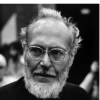W. Eugene Smith

W. Eugene Smith
William Eugene Smith, was an American photojournalist, renowned for the dedication he devoted to his projects and his uncompromising professional and ethical standards. Smith developed the photo essay into a sophisticated visual form. His most famous studies included brutally vivid World War II photographs, the clinic of Dr Schweitzer in French Equatorial Africa, the city of Pittsburgh, the dedication of an American country doctor and a nurse midwife, and the pollution which damaged the health of the residents of Minamata...
NationalityAmerican
ProfessionPhotographer
Date of Birth30 December 1918
CountryUnited States of America